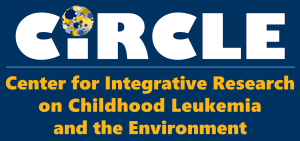Mission Statement
CIRCLE seeks to discover how environmental exposures and genetics interact to cause childhood leukemia in an effort to prevent the disease.
Related Research Projects
In addition to the important work they do for CIRCLE, our investigators contribute to a variety of other efforts to protect children’s health including:
- The California Childhood Leukemia Study (1995-2015; PI: Catherine Metayer), a case-control study of childhood leukemia conducted in 35 counties of the San Francisco Bay Area and the Central Valley. This long-standing study provides key resources for CIRCLE research projects, including biospecimens and interview data.
- The California Mother-Child Birth Cohort (2011-2015; MPI: Xiaomei Ma and Joseph Wiemels), a California statewide record linkage between birth records and cancer registry records, ascertaining all childhood and adolescent cancer cases since 1988. This study also provides key resources for CIRCLE research projects, including biospecimens and birth certificate data.
- The Childhood Leukemia International Consortium (2008-present; Chair: Catherine Metayer), a consortium of 33 case-control studies from North and South America, Europe, Africa, and Oceania that conducts pooled analyses to identify risk factors for childhood leukemia.
Collectively, CIRCLE and these other research efforts form the basis for the Integrative Cancer Research (ICARE) Group in the UC Berkeley, School of Public Health (Director: Catherine Metayer).
Funding History
CIRCLE is a Children’s Environmental Health and Disease Prevention Research Center jointly funded by the National Institute of Environmental Health Sciences (NIEHS) and the U.S. Environmental Protection Agency (EPA). CIRCLE was initiated in 2008. The first funding cycle of CIRCLE ended in 2014. A second funding cycle began in 2015 and is expected to run until 2019.
In addition to the NIEHS-EPA funding received by the Center, childhood leukemia research conducted by CIRCLE investigators has been partially-supported by the National Cancer Institute, Alex’s Lemonade Stand Foundation, and Children with Cancer – UK.
Thanks To
CIRCLE is a collaborative effort that relies on the current and past contributions of many people – the clinical investigators and staff who have helped recruit study participants from their hospitals, the researchers from the Childhood Leukemia International Consortium, the scientists and staff at the California Department of Public Health who provide resources for the Center, the research staff at all partner institutions, and, most importantly, the families who have agreed to participate in the research to help find the causes of childhood leukemia.

